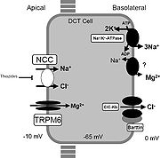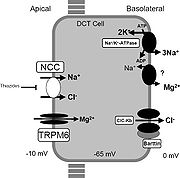
Gitelman syndrome
Encyclopedia
Gitelman syndrome is a rare inherited defect in the distal convoluted tubule
of the kidney
s. It causes the kidneys to pass sodium
, magnesium
, chloride
, and potassium
into the urine
, rather than allowing it to be resorbed into the bloodstream.
Gitelman syndrome is not to be confused with Bartter syndrome
, which is a rare inherited defect in the thick ascending limb of the loop of Henle
.

 Gitelman's syndrome is linked to inactivating mutations in the SLC12A3 gene resulting in a loss of function of the encoded thiazide
Gitelman's syndrome is linked to inactivating mutations in the SLC12A3 gene resulting in a loss of function of the encoded thiazide
-sensitive sodium-chloride co-transporter
(NCCT). This cell membrane protein participates in the control of ion homeostasis
at the distal convoluted tubule
portion of the nephron
.
Gitelman's syndrome is an autosomal
-recessive disorder: one defective allele
has to be inherited from each parent.
diuretics
Clinical symptoms for this disease are hypochloremic metabolic alkalosis
, hypokalemia
, and hypocalciuria
. Hypomagnesemia
is present in many but not all cases. In contrast to patients with Gordon's syndrome, those suffering from Gitelman's syndrome are generally normotensive. Carriers of Gitelman's syndrome-linked mutations are often asymptomatic while some complain of mild muscular cramp
s or weakness expressed as fatigue or irritability. More severe symptoms such as tetany
and paralysis
have however also been reported. Phenotypic variations observed among patients probably result from differences in their genetic background and may depend on which particular amino acid in the NCCT protein has been mutated.
See Naesens et al. for a recent review.
Distal convoluted tubule
The distal convoluted tubule is a portion of kidney nephron between the loop of Henle and the collecting duct system.- Physiology :It is partly responsible for the regulation of potassium, sodium, calcium, and pH...
of the kidney
Kidney
The kidneys, organs with several functions, serve essential regulatory roles in most animals, including vertebrates and some invertebrates. They are essential in the urinary system and also serve homeostatic functions such as the regulation of electrolytes, maintenance of acid–base balance, and...
s. It causes the kidneys to pass sodium
Sodium
Sodium is a chemical element with the symbol Na and atomic number 11. It is a soft, silvery-white, highly reactive metal and is a member of the alkali metals; its only stable isotope is 23Na. It is an abundant element that exists in numerous minerals, most commonly as sodium chloride...
, magnesium
Magnesium
Magnesium is a chemical element with the symbol Mg, atomic number 12, and common oxidation number +2. It is an alkaline earth metal and the eighth most abundant element in the Earth's crust and ninth in the known universe as a whole...
, chloride
Chloride
The chloride ion is formed when the element chlorine, a halogen, picks up one electron to form an anion Cl−. The salts of hydrochloric acid HCl contain chloride ions and can also be called chlorides. The chloride ion, and its salts such as sodium chloride, are very soluble in water...
, and potassium
Potassium
Potassium is the chemical element with the symbol K and atomic number 19. Elemental potassium is a soft silvery-white alkali metal that oxidizes rapidly in air and is very reactive with water, generating sufficient heat to ignite the hydrogen emitted in the reaction.Potassium and sodium are...
into the urine
Urine
Urine is a typically sterile liquid by-product of the body that is secreted by the kidneys through a process called urination and excreted through the urethra. Cellular metabolism generates numerous by-products, many rich in nitrogen, that require elimination from the bloodstream...
, rather than allowing it to be resorbed into the bloodstream.
Gitelman syndrome is not to be confused with Bartter syndrome
Bartter syndrome
Bartter syndrome is a rare inherited defect in the thick ascending limb of the loop of Henle. It is characterized by low potassium levels , increased blood pH , and normal to low blood pressure. There are two types of Bartter syndrome: neonatal and classic...
, which is a rare inherited defect in the thick ascending limb of the loop of Henle
Loop of Henle
In the kidney, the loop of Henle is the portion of a nephron that leads from the proximal convoluted tubule to the distal convoluted tubule. Named after its discoverer F. G. J...
.
Cause


Thiazide
Thiazide is a term used to describe a type of molecule and a class of diuretics often used to treat hypertension and edema ....
-sensitive sodium-chloride co-transporter
Sodium-chloride symporter
The sodium-chloride symporter is a cotransporter in the kidney which has the function of reabsorbing sodium and chloride ions from the tubular fluid into the cells of the distal convoluted tubule of the nephron.It is a member of the SLC12...
(NCCT). This cell membrane protein participates in the control of ion homeostasis
Homeostasis
Homeostasis is the property of a system that regulates its internal environment and tends to maintain a stable, constant condition of properties like temperature or pH...
at the distal convoluted tubule
Distal convoluted tubule
The distal convoluted tubule is a portion of kidney nephron between the loop of Henle and the collecting duct system.- Physiology :It is partly responsible for the regulation of potassium, sodium, calcium, and pH...
portion of the nephron
Nephron
The renal tubule is the portion of the nephron containing the tubular fluid filtered through the glomerulus. After passing through the renal tubule, the filtrate continues to the collecting duct system, which is not part of the nephron....
.
Gitelman's syndrome is an autosomal
Autosome
An autosome is a chromosome that is not a sex chromosome, or allosome; that is to say, there is an equal number of copies of the chromosome in males and females. For example, in humans, there are 22 pairs of autosomes. In addition to autosomes, there are sex chromosomes, to be specific: X and Y...
-recessive disorder: one defective allele
Allele
An allele is one of two or more forms of a gene or a genetic locus . "Allel" is an abbreviation of allelomorph. Sometimes, different alleles can result in different observable phenotypic traits, such as different pigmentation...
has to be inherited from each parent.
Presentation
People suffering from Gitelman's syndrome present symptoms which are identical to those of patients who are on thiazideThiazide
Thiazide is a term used to describe a type of molecule and a class of diuretics often used to treat hypertension and edema ....
diuretics
Clinical symptoms for this disease are hypochloremic metabolic alkalosis
Metabolic alkalosis
Metabolic alkalosis is a metabolic condition in which the pH of tissue is elevated beyond the normal range . This is the result of decreased hydrogen ion concentration, leading to increased bicarbonate, or alternatively a direct result of increased bicarbonate concentrations.-Terminology:*Alkalosis...
, hypokalemia
Hypokalemia
Hypokalemia or hypokalaemia , also hypopotassemia or hypopotassaemia , refers to the condition in which the concentration of potassium in the blood is low...
, and hypocalciuria
Hypocalciuria
Hypocalciuria is a low level of calcium in the urine. It is a significant risk factor for predicting eclampsia in pregnancy. It is also common in patients with Gitelman syndrome. It is also found in Familial hypocalciuric hypercalcemia....
. Hypomagnesemia
Hypomagnesemia
Hypomagnesemia is an electrolyte disturbance in which there is an abnormally low level of magnesium in the blood. Usually a serum level less than 0.7 mmol/L is used as reference. The prefix hypo- means low . The middle 'magnes' refers to magnesium...
is present in many but not all cases. In contrast to patients with Gordon's syndrome, those suffering from Gitelman's syndrome are generally normotensive. Carriers of Gitelman's syndrome-linked mutations are often asymptomatic while some complain of mild muscular cramp
Cramp
Cramps are unpleasant, often painful sensations caused by muscle contraction or over shortening. Common causes of skeletal muscle cramps include muscle fatigue, low sodium, and low potassium...
s or weakness expressed as fatigue or irritability. More severe symptoms such as tetany
Tetany (medical sign)
Tetany is a medical sign consisting of the involuntary contraction of muscles, which may be caused by disease or other conditions that increase the action potential frequency...
and paralysis
Paralysis
Paralysis is loss of muscle function for one or more muscles. Paralysis can be accompanied by a loss of feeling in the affected area if there is sensory damage as well as motor. A study conducted by the Christopher & Dana Reeve Foundation, suggests that about 1 in 50 people have been diagnosed...
have however also been reported. Phenotypic variations observed among patients probably result from differences in their genetic background and may depend on which particular amino acid in the NCCT protein has been mutated.
See Naesens et al. for a recent review.

